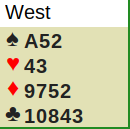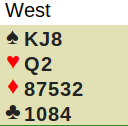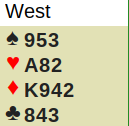AuthorThis is going to be a long series. When you have the hand for it, raising partner is almost always the right move. This is the rationale behind countless conventional agreements. In this series I will present my ideas about the very important topic, delving in great detail into each situation. Raises in the unimpeded auctionMajor suit raises (A later article will deal with direct minor suit raises, since they are rarer -- standard bidding often focusing on searching for major suit fits even when you have an otherwise serviceable raise for your partner's opening minor suit.) . The 1 Major - 2 Major raise (henceforth referred to as 1M-2M), in a five-card major system, is an enormously useful bid. It immediately identifies what is the best strain for game (in >95% of the time -- only 3NT is in the running after this start), and defines the strength of responder to such an extent that opener can very often decide whether to bid game or to stop low. There are two main schools of thought as to which strength should this bid show: "obstructive" or "constructive". The first group likes to raise an opening bid of 1 Spade with hands as weak as these: Constructive raisers would require at least one extra King in these examples (as a minimum for the bid). If you want to think in terms of high card points (HCP), obstructive raises are nominally from 5-9 hcp, and constructive raises, from 8-10 hcp.
(Note that the quality of the support covers a multitude of sins. With xxx and a 4333 hand, you really should tread carefully. On the other hand, with honors in the suit you are raising and a ruffing value, your hand grows). All my life I have been an obstructive raiser. I love to raise with these hands. It is a very successful style. That said, I have been trying (in a Precision context) the constructive style for the past 6 months and I have had no complaints about it either. Raises are so good that they work for you, whatever is your agreement! How should the bidding continue after a simple raise from 1M to 2M? What most people play is something like this: 2NT, 3 of another suit - trial bids (at least game invitational). Some pairs use the next step (2M+1) artificially to have two kinds of trial bids, long and short (or, help-suit). 3 of our suit (reraise) - preemptive, no interest in bidding higher Jumps in new suits - shortness (0-1), slam invitation 3NT - 5332 hand, 18-19 hcp I don't like these bids. First of all, I don't like having so many ways to invite. I hate to invite partner to game. I have sound reasons for that. Inviting means raising the level of the contract (at least in this auction -- there are other auctions, imagine a Drury 2 Clubs by a passed hand for example, in which you can show invitational strength without raising the level). That means that some percentage of the time you will stop in 3M and go down. Another problem with that plethora of invitational bids is that they describe your hand (which will be declarer!) too much. They help the opposition. Bashing your game try into a direct game bid (1M - 2M - 4M) has much to gain. Granted, this is an IMP-based argument, and in matchpoints one should be more inclined to preserve the plus score and -- against competent opponents -- to prefer to pass (in 2M) some hands with which he would be tempted to invite at IMPs. This is an important subject that deserves an article of its own, but I will skip that for now and present what I believe to be the best set of agreements for the auction 1M - 2M. Using Spades as our example (1S - 2S): 2NT - any invitation. (I'm not showing anything about my hand to you guys). This is the only invitational bid. It may be game forcing (and it will show this later), but never with slam interest. 3 of another suit - game forcing, slam interest, showing a ruffing value. This is not the same notion as "shortness". It can be done with a doubleton. (Of course, hands without a singleton that are interested in slam are very strong. But they show up now and then). 3 of our own suit - 7 tricks in NT, with 6 cards in spades. Typically a 6322 (or perhaps 6331 with a singleton honor) that is hoping to find 2 quick tricks (2 Aces, an Ace and a King in our own suit, something like that) to bid 3NT rather than 4S. Imagine AQJxxx Axx Ax xx opposite Kxx xxxx xxx Axx. I think this treatment is very much more useful than the preemptive reraise, especially when we have the spades. (When we have hearts, the argument is weaker, but I play it the same way for consistency). If we want to bid 3S after they balance, we can do it later. This is not an auction that is likely to spiral out of control. Why would we voluntarily bid 3 Spades when sometimes they let us play 2 Spades? 3NT - Typically a 6322 (like the hand above) with one extra trick. In other words, 8 tricks in hand. (AKJxxx Axx Ax Jx for example). We are gambling that partner's cards will help us to reach the magic number nine. If responder is maximum or distributional he may, of course, correct to 4S. But with a minimum and no singleton he should lean towards passing in 3NT. 4 of a new suit - slam interest, void showing. You may have noticed that in the ancient controversy of what features should be shown by opener, I lean decisively on the side of shortness. And you haven't seen all of it. How should responder proceed? Over the 2NT bid, he should bid game with any maximum. I hate inviting, but I love accepting. If responder is in doubt, he can bid his side strength to help partner judge whether to stretch to game or not. (Note that we are showing dummy's hand to the opponents, rather than declarer's). And if he has a minimum he should simply return to 3 of our trump suit. Easy peasy. One thing should be noted though: if opener, over responder's sign-off, bids 3NT, he has the 18-19 5332 kind of hand, and responder should decide where to play with that information. Over the 3 of a new suit showing a ruffing value (most often a singleton) and slam interest, responder should evaluate his hand according to whether his (meager) collection of honors is fitting well and flag this evaluation to opener, like this: If his honors fit partner's hand (he has no minor honors (K, Q, J) in opener's short suit), he should bid a ruffing value of his own. So, for example, if you have Axx xx xxx Kxxxx and the bidding started 1S-2S-3D, you give your partner the good news of no duplication in diamonds by bidding 3H (your own ruffing value). Note that both partners are bidding ruffing values at the 3-level. This helps to gauge the playing strength of the hand (and it is also a sign that the 4th suit, the one in which neither partner has a ruffing value, is a possible trump suit. You probably have seen the hands in which the 5-3 fit makes one less trick than the 4-4 fit. Well, both partners should be aware of this possibility when it comes to the 4th suit). Whether or not someone has a control in these suits is a question to be solved later. What if you have a nice fit for partner (no duplication in his ruffing value) but no ruffing value of your own? You bid 3NT. You are showing a 4333 hand (you may have 4 spades, by the way) without honors in partner's ruffing value. If your hand is bad news for partner (honors in his ruffing value), you return to our trump suit. (You never jump to game in this auction -- 3M is enough to indicate your negative attitude). And if you have "the best hand imaginable" (you will know it when you see it -- imagine something like AQx Kx xxxxx xxx after 1S-2S-3D, if your raise is 5-9), you raise partner's ruffing value (1S-2S-3D-4D, in this example). Finally, to wrap up this first article, if partner jumped (showing a void), e.g. 1S-2S-4D, you evaluate your hand according to the same principles, and you bid your ruffing value if your hand warrants it. Remember, if partner is inviting slam with a void and you don't have honors there, you are surely safe at the 5-level (unless partner is a maniac, then you discuss it with him later). Don't worry about bypassing 4M in this scenario. One adjustment that can be made when the major suit is hearts (if you are willing to spend the memory effort for it) is to use 2S (2M+1) as the general invitational bid. 2NT then becomes "ruffing value in spades". And 1H-2H-2S-2NT means honors in spades and doubt about game. (2NT by any partner refers to spades). In the next chapter we will look at 3-level raises.
0 Comments
Leave a Reply. |
Archives
September 2021
Categories
All
|



 RSS Feed
RSS Feed